
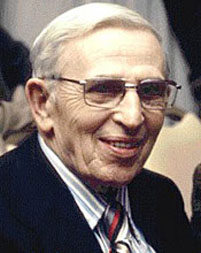 X Minus One (1955-58) aired “Project Mastodon” on June 5, 1956 as its 54th episode. This novelette by Clifford D. Simak (1904-1988) first saw print in the March 1955 issue of Galaxy. For those new to science fiction and not familiar with Simak (pronounced with a short “i” as in “simple”) I borrow an introductory paragraph from a 1975 interview I was fortunate enough to have done with Cliff, and then for the first time posted online here. The paragraph reads:
X Minus One (1955-58) aired “Project Mastodon” on June 5, 1956 as its 54th episode. This novelette by Clifford D. Simak (1904-1988) first saw print in the March 1955 issue of Galaxy. For those new to science fiction and not familiar with Simak (pronounced with a short “i” as in “simple”) I borrow an introductory paragraph from a 1975 interview I was fortunate enough to have done with Cliff, and then for the first time posted online here. The paragraph reads:
“One of science fiction’s earliest pioneers, Cliff saw his first science fiction story published in the December 1931 issue of Wonder Stories. He left the field for a few years in 1933 only to return when John W. Campbell became editor of Astounding in 1938 and ushered in what many consider to be the first Golden Age of SF. Cliff took home an International Fantasy Award for Best Novel in 1953 for City (a collection of stories first published in Campbell’s Astounding), beating out novels by Cyril Kornbluth and Kurt Vonnegut, Jr. (Vonnegut’s Player Piano, no less). In 1959 he won a Hugo for his novelette “The Big Front Yard,” in 1964 he would win another Hugo for his novel Way Station, and in 1981 he made a clean sweep with four awards for his short story “Grotto of the Dancing Deer.” “Grotto” won the Analog Analytical Laboratory Award (the publication where it saw print), the Hugo, the Nebula, and the Locus Award. In 1976 (the year following this interview) Cliff was named SFWA’s third Grand Master, following only Robert A. Heinlein (1974) and Jack Williamson (1975), and in 1988 he was honored with the Bram Stoker Lifetime Achievement Award.”
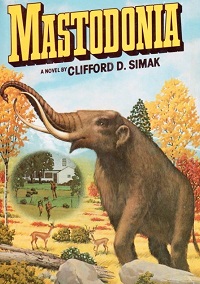 “Project Mastodon” is a clever little time-travel story where some enterprising enterpreneurs making their home 50,000 years in the past figure out they can maybe make a buck or two if they can declare their new home–which they call Mastodonia–an independent state, thus giving it certain rights, not the least of which are economic and trade. But there’s a hurdle to be overcome, of course, for nothing is easy. They must acquire this legal status from the current United States government in the present–50,000 years in their future. This rather whacky and unprecedented request is weighed for its pros and cons by the politicians with the power to grant or deny such a landmark request (and we know how politicians work). But this isn’t the only barrier, as something even stranger comes to light that may throw a monkey wrench into the whole affair. Leave it to Cliff Simak to consider a wrinkle no one had thought of, which makes this one of the more interesting and fun time-travel stories to come from the still (and forever) popular trope of time travel.
“Project Mastodon” is a clever little time-travel story where some enterprising enterpreneurs making their home 50,000 years in the past figure out they can maybe make a buck or two if they can declare their new home–which they call Mastodonia–an independent state, thus giving it certain rights, not the least of which are economic and trade. But there’s a hurdle to be overcome, of course, for nothing is easy. They must acquire this legal status from the current United States government in the present–50,000 years in their future. This rather whacky and unprecedented request is weighed for its pros and cons by the politicians with the power to grant or deny such a landmark request (and we know how politicians work). But this isn’t the only barrier, as something even stranger comes to light that may throw a monkey wrench into the whole affair. Leave it to Cliff Simak to consider a wrinkle no one had thought of, which makes this one of the more interesting and fun time-travel stories to come from the still (and forever) popular trope of time travel.
Twenty three years following the publication of the original novelette, Simak would turn the story into a full-fledged novel, with Del Rey publishing Mastodonia in 1978.
1956 saw New York City hosting the 14th SF worldcon, NYCON II. Robert A. Heinlein won the Hugo for Best Novel for Double Star (serialized in Astounding from Feb. to April 1956), Murray Leinster (Will F. Jenkins) walked away with the Hugo for Best Novelette for “Exploration Team” (also appearing in Astounding, in the March 1956 issue), and Arthur C. Clarke would cop the Hugo for Best Short Story for “The Star,” which appeared in the November 1955 issue of Infinity, the magazine’s debut issue.
Play Time: 23:14
{With thoughts of the upcoming summer vacation driving their thoughts and feet, the neighborhood gang would step with light hearts on their way to the corner newsstand on a Saturday morning in June of 1956. After listening to “Project Mastodon” they were definitely in the mood for some solid science fiction, and the three magazines showcased below gave them everything they could wish for. Astounding and The Magazine of Fantasy and Science Fiction held to their solid monthly schedules. Infinity Science Fiction was the newcomer on the block, seeing its first issue in November of 1955. It would publish 20 irregular issues through 1958 before its short run would end. The issue below was its third.}
[Left: Astounding, June 1956 – Center: Infinity, June 1956 – Right: Fantasy & Science Fiction, June 1956]
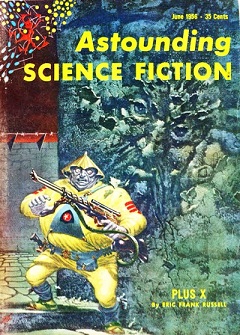
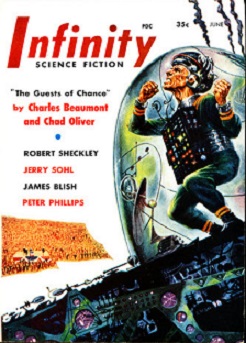
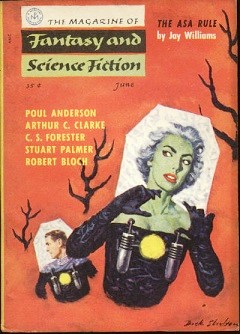
To view the entire list of weekly Old Time Radio episodes at Tangent Online, click here.